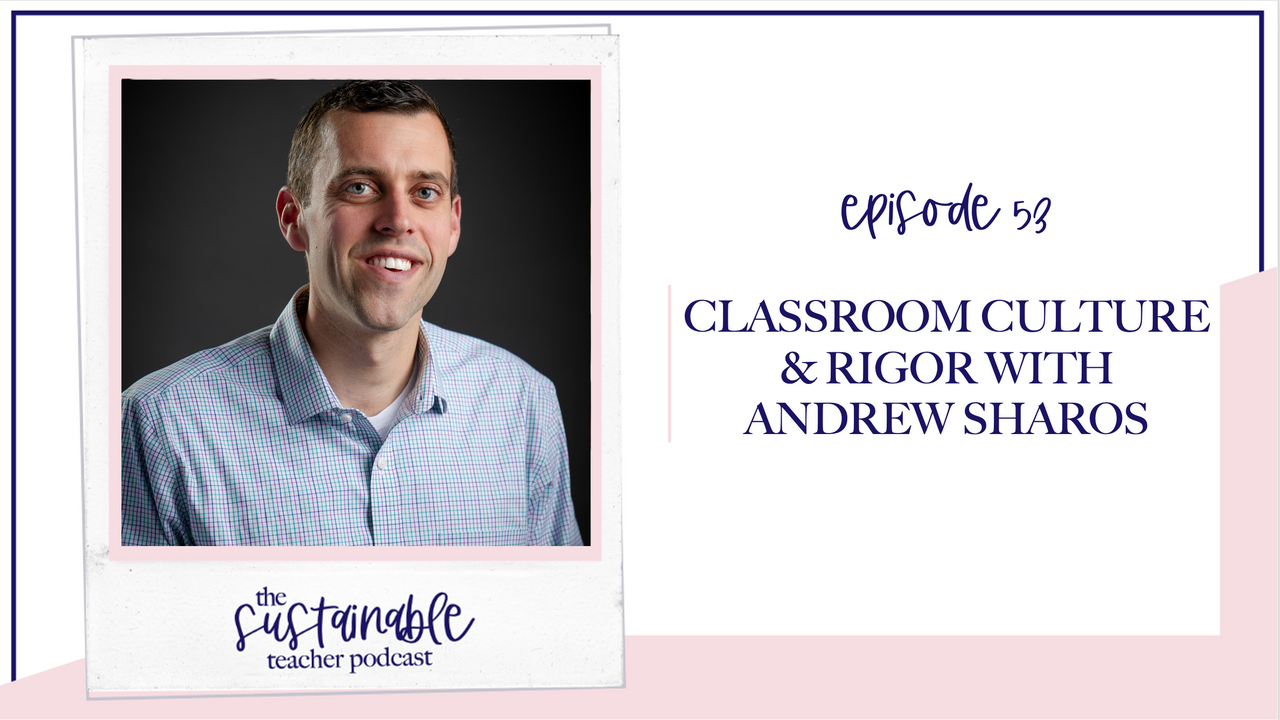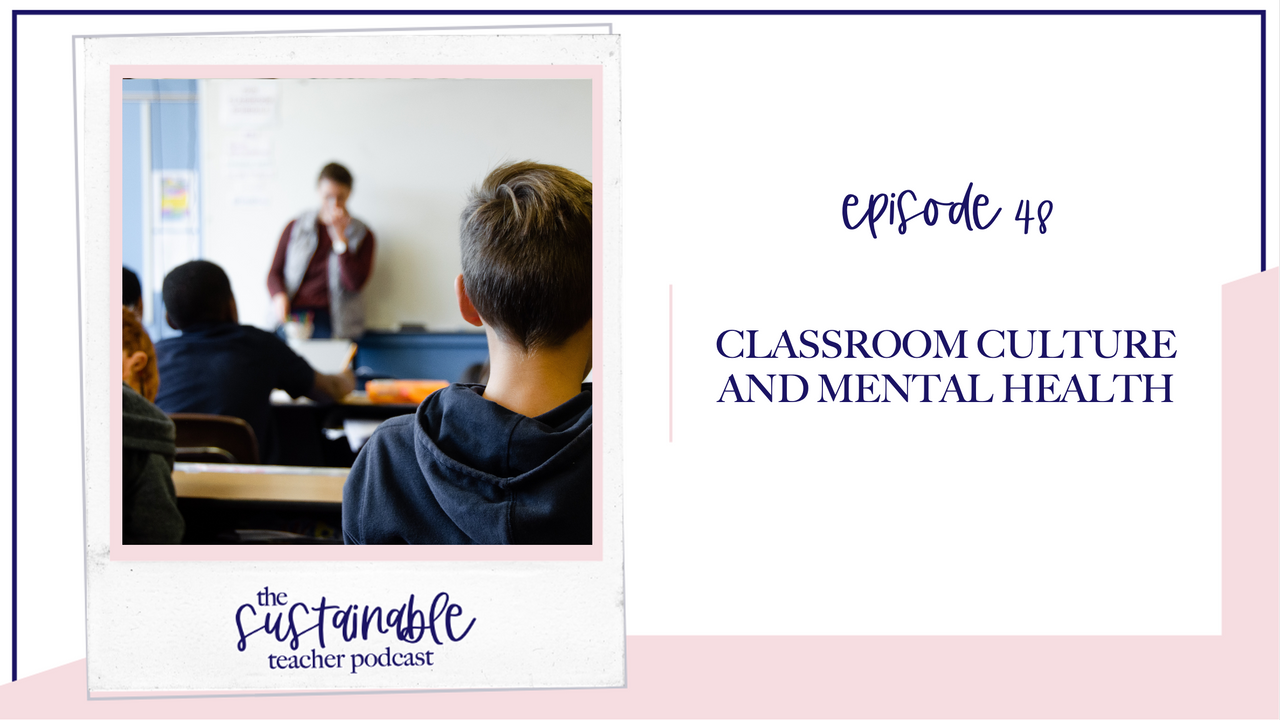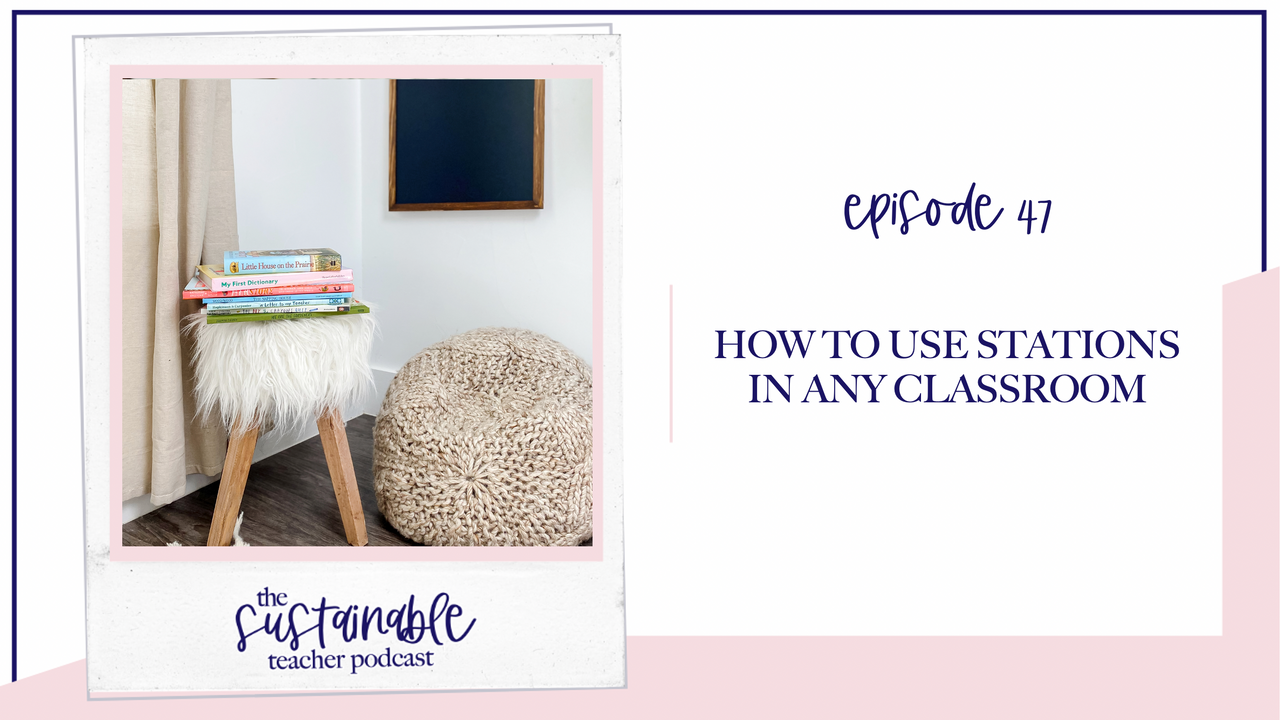Top 5 Attributes of My Classroom Culture

Welcome back to the Sustainable Teacher blog episode 56, the Top 5 Attributes of a Sustainable Classroom Culture, and here’s the very first thing I want to say.
I think there should be an entire college course on classroom culture. I don’t say that about many things. I teach Intro to Educational Technology, and I think a course on classroom culture should come first. And here’s why… because it’s one of the top, if not THE top factor that will determine your sustainability and impact in your career.
It’s this awesome mix of knowing what you believe as an educator and making sure you always act from that space, helping you to recognize that your impact is greater than any mastered standard or test score.
So, I’ve got five of them for you today, and they each of a message of sorts that you could be sending to your students. And they are a part of a sustainable classroom culture because they compromise the messages, systems, beliefs and actions of your classroom that determine how...
Do You Really Want A Job You Don't Have To Take Home?

As I’m sitting to write this episode, I’m in an approximately six square feet space in the cab of our pick up truck pulling our camper on our way home from our Christmas vacation with three boys and our dog. I’m reflecting on what was by far our best camper-trip yet as it was at the beginning of winter and was full of sunshine which we Midwesterners aren’t used to in December.
It was a great refresh.
But you know what I thought about quite a bit? Work.
Not in a way that was stifling to my or our enjoying the trip. Not at all. We just had a lot of relaxation time. And that meant my mind was able to wonder and think and plan.
And it reminded me of how I was with my classroom when on a break or vacation.
When I was able to step back from it, I was able to think about it in a clearer way. I was able to work on my classroom rather than in my classroom.
Today I’m asking you the question, in a very non-rhetorical way, do you really want a job you don’t have to take home, becaus...
Revisiting Your Teacher Why in 2022

Last semester I had the privilege of working with mostly freshman students at a local university in an Introduction to Educational Technology course. This was one of the very first education courses many of my students were taking, and I appreciated the perspective of a college student with next to no experience in education, but the drive to know as much as they could about strategies and best practices to implement in their future classrooms.
What I discovered in conversations with many of my students is that although they hadn’t much experience yet, they all had stories and the first stages of what will become their why as teachers.
Now you may be someone who knows your why, is grounded in it, and acts from that space more days than not. But you also could be someone who hasn’t had the time to consider what your why might be because, seriously, who’s got time for that right?!?
Whether you are a teacher who’s known your why for a decade or hasn’t yet discovered it, I would li...
Classroom Culture and Rigor with Andrew Sharos

Welcome back to the Sustainable Teacher Podcast, I am your host, Mandy Rice, a ten year teacher turned biggest teacher supporter in building sustainable classrooms so you can stay there longer, and today on the show we have Andrew Sharos, the author of Finding Lifelines and All 4s and 5s, a teacher then administrator, and now an administrator and teacher and school supporter, providing professional development and support to schools around the country.
In today’s episode, Andrew and I are talking about his book, All 4s and 5s, whose title is referring to the highest scores a student can get on the AP Exam. For those who don’t know, AP stands for Advanced Placement, and is a global curriculum in over 30 courses run by an organization called CollegeBoard, and at the end of each course, in the month of May, across the world, hundreds of thousands of students take a summative test to prove how much they learned in that course. That test is scored on a scale of 1 to 5, and most colleg...
Teacher Tech Series Part Four: 3 Tips to Clean up Email

Kids have just left your room, you grab your lunch from the fridge and decide to have a working lunch (because, yes, those are ok to have every once in a while) in the peace and quiet of your empty classroom, and as you sit down and open your laptop, you immediately lose all semblance of peace and quiet when you open your email to find 15 new emails amid your inbox that already has over 200 messages needing your attention.
Among those emails are no less than a few reminding you of past emails you have not responded to yet, and there goes your peaceful and lite working lunch.
Much like we talked about in last week’s episode referring to project management and all the roles we fill as teachers, we are filling the position of around 5 people. It’s high time we start acting like someone who fulfills 5 positions by using a project management tool, and by streamlining how we handle our email inbox.
After listening to this episode you’ll be ready to tackle what is possibly the most tri...
Teacher Tech Series Part Three: Calendar and Project Management

You’ve already taken the big step in being more efficient with your lesson planning by doing it digitally like we talked about back in episode 50, now it’s time to take it one step further, and really it just makes sense to take it one step further with your time and task management as a teacher. Here’s the truth, as much as what we do in helping kids learn can be super simple, as educators we have plenty of spinning plates in the air. We are in charge of lots of projects and other moving parts of our day, leaving us with somewhere around ten things we’re managing at any given time. There’s got to be a better way to manage all that we do other than in a paper planner or calendar.
Because, here’s the thing… The management of time and tasks is the greatest low-grade, yet constant stressor of life, is it not? Especially for teachers. The autonomy we have as teachers is truly one of the best aspects of the career field in my opinion, but the inability to think long term and manage...
Teacher Tech Series Part Two: Digital Lesson Planning

When I first started teaching, I hated lesson planning. I loved teaching from day one, but when I had to sit down and write out plans I was doing it on someone else’s terms (meaning it wasn’t in the format that was helpful to me), and I knew by writing it down I would look at it once and then have to redo it again next year.
I hate doing things twice.
That’s when I stopped writing my lesson plans on paper and kept them completely digital. Most teams I worked on did the same, which gave us a huge advantage because then our plans were sharable. That’s a total game changer when it comes to collaboration for a team - seriously, it was beautiful.
Collaboration and team planning is one of the biggest benefits to digital lesson plans, but there are many others, and I want to point you to episode 5 of this podcast where I give 3 Steps to Sustainable Planning, and the first step is to go digital. In that episode I talk about the benefits, so that this episode picks up where it left of...
Teacher Tech Series Part One: Parent Communication

Welcome back to the Sustainable Teacher, I hope your week so far is going as smoothly as possible, and that you have found this episode at just the right time, whenever that time might be for you. This episode will be a conversation about EdTech, but more so on the technology that is teacher-facing, and less student-facing.
Oftentimes in conversation and professional development involving educational technology, the focus is on student-facing technology and what newest tool can be used to have impact in your lessons. Although It's not bad that this is the main focus, it’s not the only way that technology can benefit a teacher and a classroom. So in this episode we’ll be talking about teacher tech and how to leverage technology to make a part of your day more sustainable, and the part of your day we’ll focus on in this episode is parent communication.
Sure, technology, in most areas, is great. It improves efficiency and even sustainability, but only if those are our intention...
Classroom Culture and Mental Health

During the ten years I spent in the classroom, I taught AP® Psychology all of those years. I attended numerous content-specific professional development opportunities, flipped the entire curriculum that is readily available for free on my YouTube channel, as well as built resources that many teachers find helpful in my Teachers Pay Teachers store or in our Sustainable Psych Teacher membership. I’m sharing all of this to say that I became, and hopefully remain, well versed in the AP® Psychology curriculum - I would even venture to say I’ve got my 10,000 hours Malcolm Gladwell teaches about as indicating expertise, at least in the curriculum that is… but certainly not in the field of psychology.
So as much as I know and love psychology, I am by no stretch of the imagination a psychologist, psychiatrist (shout out to my psych nerds who know the difference), or a mental health professional. No advice I give today in this episode is advice for handling mental health. No. Instead it...
How to Use Stations in Your Classroom

Are you ready for a very practical, how-to episode today? I hope so, because that’s exactly what I’ve got for you when it comes to implementing stations. I try not to overwhelm you on this podcast with “implement this now and solve all your problems” strategies, because that’s just not how things work, and, at least for me, learning all kinds of new things just clouds my thinking and vision, and I end up accomplishing less.
However, a nice how-to every now and then can be refreshing, and I hope that today’s episode is that for you, and it’s all about stations and how they can be used in any classroom.
Now, who could use stations, what classrooms or students would it benefit? And I want to answer that question before we get started. Really, any teacher at any grade level can use stations, but I recommend the use of stations, and wrote today’s episode especially with the teacher in mind who’s been doing things the same way for a while and might just need a little bit of...


